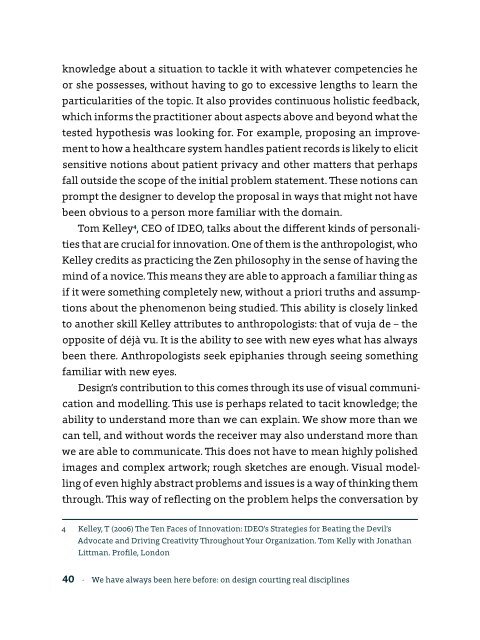Designing for wellbeing
Designing for wellbeing
Designing for wellbeing
Create successful ePaper yourself
Turn your PDF publications into a flip-book with our unique Google optimized e-Paper software.
knowledge about a situation to tackle it with whatever competencies he<br />
or she possesses, without having to go to excessive lengths to learn the<br />
particularities of the topic. It also provides continuous holistic feedback,<br />
which in<strong>for</strong>ms the practitioner about aspects above and beyond what the<br />
tested hypothesis was looking <strong>for</strong>. For example, proposing an improvement<br />
to how a healthcare system handles patient records is likely to elicit<br />
sensitive notions about patient privacy and other matters that perhaps<br />
fall outside the scope of the initial problem statement. These notions can<br />
prompt the designer to develop the proposal in ways that might not have<br />
been obvious to a person more familiar with the domain.<br />
Tom Kelley 4 , CEO of IDEO, talks about the different kinds of personalities<br />
that are crucial <strong>for</strong> innovation. One of them is the anthropologist, who<br />
Kelley credits as practicing the Zen philosophy in the sense of having the<br />
mind of a novice. This means they are able to approach a familiar thing as<br />
if it were something completely new, without a priori truths and assumptions<br />
about the phenomenon being studied. This ability is closely linked<br />
to another skill Kelley attributes to anthropologists: that of vuja de – the<br />
opposite of déjà vu. It is the ability to see with new eyes what has always<br />
been there. Anthropologists seek epiphanies through seeing something<br />
familiar with new eyes.<br />
Design’s contribution to this comes through its use of visual communication<br />
and modelling. This use is perhaps related to tacit knowledge; the<br />
ability to understand more than we can explain. We show more than we<br />
can tell, and without words the receiver may also understand more than<br />
we are able to communicate. This does not have to mean highly polished<br />
images and complex artwork; rough sketches are enough. Visual modelling<br />
of even highly abstract problems and issues is a way of thinking them<br />
through. This way of reflecting on the problem helps the conversation by<br />
4 Kelley, T (2006) The Ten Faces of Innovation: IDEO’s Strategies <strong>for</strong> Beating the Devil’s<br />
Advocate and Driving Creativity Throughout Your Organization. Tom Kelly with Jonathan<br />
Littman. Profile, London<br />
40 · We have always been here be<strong>for</strong>e: on design courting real disciplines
















